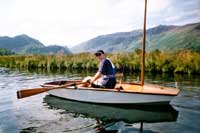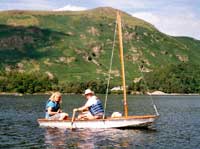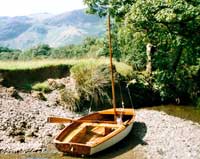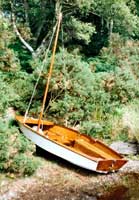Pampering the Old Lady
Some of you may remember references to my father's
old sailing dinghy, Swift Willow. Built around two decades ago
to Percy Blandford's plans for the Goblin
(now available from Clarkcraft)
she has done sterling work over the years carrying a growing
family on day trips in Scotland and the Cumbrian Lakes. She
has taught a generation of Waseys to row and sail and has attained
something of the character of an ageing family dog: slow to
anger, always careful of her load and quick to wag her foaming
tail at the opportunity for a new adventure.
 |
The author rowing Swift Willow up the
River Derwent amidst the breathtaking Cumbrian scenery.
(click image to enlarge) |
Like an old family dog, she also had not been
groomed for many a year. The fibreglass covering her keel showed
ominously dark, the varnish was threateningly light-coloured
and flaky and she was showing her age. Eventually she made it
into my workshop - an old farm building that I sub-let from
a dealer in wooden rowing boats: a dusty creaking building without
light, heat or running water, with power provided by my tiny
and occasionally obstreperous 650W generator. In it's musty
warmth she was to have the patina of the years removed and replaced
by a new finish, fit to keep her sailing for another twenty
years.
The first job, which I handed to my father was
to strip the fibreglass from the keel, in which I was reasonably
convinced that there was rot. This was a horrible job, the fibreglass
having an unexpected tenacity in the face of chisel and hammer
until after some hours labour the whole keel lay open to inspection.
Happily we found nothing other than a little water in the keel,
which in itself made the effort worth while: we knew we were
working on a sound foundation.
I dreamed of stripping the whole hull, extensively
covered with fibreglass, back to bare wood. The generator was
started, ear protectors, mask and goggles donned, and the belt
sander with a 60 grit belt (the most aggressive I have) applied
to the exterior of the hull. Dust clouds flew (extraction is
impractical, I rely on a stiff breeze blowing through the building
to keep dust levels safe) and varnish peeled from the fibreglass,
whipping with a stinging force against any exposed skin. After
an hour's work, taking a break to drink some water and de-fog
my goggles, it was clear that I needed a tactical re-think if
I was to have her finished for the deadline of the family holiday
in Cumbria.
Derwentwater looking North towards Keswick and the
slumbering mountain of Skiddaw.
(click image to enlarge)
|
|
I decided that as the boat had been built as a
family boat, it made sense to reflect this. Given the matured
state of the exterior it made most sense to knock the worst
of the old varnish back to make a good, solid base for a new
coating and neaten up the glassfibre and nicks and gouges that
20 years' rocks had caused. I worked for several more days sanding,
filling, sanding some more, NS smoothing out the keel before
I was happy with the results.
I discussed the re-finishing options with my Father.
We both wanted a bright finished boat, but the mixture of fibreglass
and the sun had rendered the exterior a curious hotch-potch
of bleached wood and darkened polyester. With reluctance Dad
agreed to painting the hull white, although I wanted to save
the appealing mahogany of the transoms. I had seen a similar
colour scheme for many years: family friends who holiday with
my parents had built a Siren - the larger sister of the Goblin
- after being inspired by seeing and sailing Swift Willow. Descended
from a boatbuilder they made an excellent job of Captain Pugwash,
built light for speed and a truly beautiful boat.
 |
Captain Pugwash piloted across Derwentwater by family
friends with Dilan the dog on lookout. Catbells and
the western shore lie behind them.
(click image to enlarge)
|
I rubbed Swift Willow down thoroughly and treated
all the exposed wood with a wood preserver. The transoms and
gunwales were gingerly masked, a skill I have yet to truly master;
and a thick white undercoat rolled on. The transoms and gunwales
were left unsanded at this point, because I knew that in the
event of my masking failing it would be easy to wipe or scrape
paint off without leaving any in scratch marks to mar the varnish
finish.
Two top coats later and I had a pleasing gloss
"workboat" finish. Up close she was honest: the years
of love showed; but from a distance she looked neat, clean and
well-cared for. The paint was allowed to dry for a couple of
days before my Father was drafted in again to help roll the
hull.
She rolled easily and was blocked up on polystyrene
in an attempt to avoid marring the fresh paint. The inside of
the boat had fared better than out and the powersander was dispensed
with. I followed the same hand-sanding schedule as I had on
the exterior. 80 grit was used for an initial bite and to take
out the worst blemishes. A number of corners, for example the
edges of the rowing thwart, were radiused to help the varnish
adhere well. Once I was happy with the boat I worked up through
120, 180 and 240 grit. I find that beyond 240 grit my brush
marks show more than the sanding marks, so it's not worth worrying
too much. The masking had been removed and the transoms and
gunwales were given a similar treatment.
Swift Willow lies at the limit of my navigation of
the river.
(click image to enlarge)
|
 |
There then transpired an almost unheard-of event:
I bought a new litre tin of varnish! I'm usually terrible for
scraping the last bits out of the bottoms of tins to do small
projects, but for once I had a large varnishing project and
I intended to thoroughly enjoy doing it. In the open areas of
the boat it was a real pleasure to roll out the quality International
varnish with a foam roller, and smooth it out with a good quality
brush. The ground round the boat was soaked with water in an
attempt to limit the dust in the finish, and after two lovingly
applied coats I was very pleased with what I'd achieved. There
were a couple of small areas that wanted another coat of varnish,
but with only a day's drying time before the boat would be racked
on top of Dad's car I accepted defeat and satisfied myself with
a hasty coat of varnish on tiller, rudder and daggerboard.
Returning two days later, I was initially disappointed
with how much dust was in the finish, but the light in the shed
falls oddly and highlights all the imperfections: on carrying
the boat into the open air the sun hit the new varnish and the
boat gleamed as she had not gleamed for many years. We rolled
her upside down again and hastily screwed a new carpet-grip
rubbing strip to the boat. I had tried to get galvanised keelband,
but my supplier was sold out and not expecting another order
for months, so we made do, knowing the boat would only be out
in the weather for a few weeks. She was hoisted to the roof
of the car and securely lashed ready for her journey to the
lakes.
I only managed to make it to the lakes for two
brief weekends, but managed to get two excellent sails and a
row in that time, the fourth day being taken up with a circumnavigation
of the lake by canoe. I hadn't sailed her for two years, but
jumping in to the old girl was like coming home. I'm much taller
and two stones heavier than when I last sailed her so the boom
was less forgiving, and in the flukey winds of the lakes I had
to be careful about trimming, which she amply rewarded by screaming
around the lake, romping to windward and fairly flying of the
wind. She's not a planing boat, at least not with my weight
in her, but given the right wind in the right place she enjoys
kicking up her heels. I thoroughly enjoyed re-aquainting myself
with her. Perhaps the greatest moment was when the cloud parted
over the western hills in the evening and a mild golden light
left the fresh varnish and mahogany of the foredeck beam to
flush and gleam.
 |
A scene almost straight from a Ransome novel, Swift
Willow lies drawn-up on the shores of Derwent Water.
(click image to enlarge)
|
The parents had a great time with her, although
they rely on more sedate methods of propulsion. With Dad's bad
back and two small dogs they prefer an elderly two-horsepower
yamaha, which fails on them far more frequently and disastrously
than the wind ever fails on me! They particularly liked the
new metal keel runner as it allowed them to drag the boat up
the slate beach without damaging either the paintwork or any
ageing muscles.
When the boat returned from it's three-week holiday
I was pleased to see how well the finish had held up. We had
not extended the keel band either side of the daggerboard slot
as we were struggling for time and didn't want to make a mess
of the trickier fitting that this entailed, so the paint there
had taken a bit of a beating. Elsewhere there were only two
blisters where old varnish which had proved annoyingly unyielding
when attacked with a sander had fallen prey to the elements.
I enjoyed the whole process so much I'm tempted
to do it all again next year and correct the few mistakes I
made: another layer of varnish will keep her sparkling; the
blisters want investigating and refinishing, and the keel wants
the proper protective strip on it...
...but then, these jobs are never quite done are
they?
Take Care
Alistair Wasey

